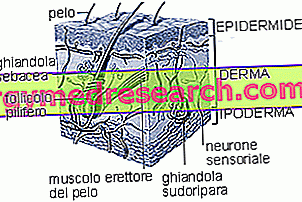The skin, or skin, is a continuous fabric, belonging to the integumentary system. It is composed of three main layers which, from the outside towards the inside, take the name of: epidermis, dermis and hypodermis (or subcutaneous layer).

The skin has two fundamental and extraordinary properties: self-repair (regenerates itself following a lesion) and extensibility (it adapts perfectly to the variations in body size that occur over the course of a lifetime).
The skin performs numerous and very important functions:
- protects us from trauma, ultraviolet radiation, microorganisms and chemical agents.
- Prevents the loss of liquids; if for example a burn causes the destruction of a tenth of the skin surface, the loss of liquids and electrolytes can lead to deadly consequences.
- Participates in the mechanism of thermoregulation, taking advantage of the intervention of sweat glands and the ability to regulate blood flow, increasing (vasodilation) or slowing (vasoconstriction) heat dispersion. The hypodermis, the deepest layer of the skin, retains more heat as its lipid thickness increases; for this reason overweight people suffer most from the summer heat.
- Coordinates the immune response against tumors and pathogens.
- The skin has metabolic properties, since the synthesis of vitamin D occurs precisely at the skin level. The skin is also an important lipid reserve.
- The skin also has a very important sensory function: with its most superficial layer it registers and transmits pressure (tactile), painful and thermal stimuli, while with the deeper one it also perceives thermal and vibratory signals.
Insights
| The epidermis | Histological and functional organization of the five layers that make it up |
| Differentiation of keratinocytes | Cell renewal of the epidermis: what it is, how it happens, what is affected by it |
| Skin and dehydration | The skin is an effective protective barrier against dehydration, we see this precious feature in detail |
corneocytes bodies of Odland natural factor of hydration | Hydroplipidic film and epidermal lipids: how they are produced, what functions they cover and why they are so important for the health of our skin |
Skin colour and melanin | What does skin color depend on? What are the functions of melanin? |
| Changes in skin color | What is the significance of the various spots, clear, dark and in relief present on our skin? |
| Solar radiation | Sun exposure and dangers to skin and health |
| The dermis | It is the middle layer of the skin, in this article we examine its histological and functional characteristics. |
| hypodermis | It is the deepest layer of the skin, a connective tissue consisting of a scaffold of connective fibers, between whose meshes lipid clusters are inserted. Interesting insight into white and brown adipose tissue |
Sweating Apocrine Giandole Sebaceous glands | In the skin we find three types of glands: sweat, apocrine and sebaceous. Each of them has a very precise functional meaning, let's see which (with interesting references to acne and seborrhea) |
Hair follicles Hair and hair The nails | They are part of the skin appendages and have particular functions that we will examine briefly after having grasped their histological characteristics |
| Skin aging | Skin aging is an inevitable biological phenomenon, understanding its causes can help slow it down |
| Dermatitis | Under the term dermatitis there are various skin diseases, mostly characterized by inflammatory phenomena. |
| Dry skin | The problem of dry skin and the strategies to solve it |
| Oily skin | The problem of oily skin and the strategies to solve it |
| Nickel: nickel allergy | Nickel allergy is the most common cause of allergic contact dermatitis, a disease that produces skin lesions very similar to those of eczema. |
| Patch test | The patch test is a test used for diagnostic purposes to identify those substances that, once placed in contact with the skin, determine a local inflammatory reaction. |
| Goose bumps | Goose skin or anserine skin is characterized by the transient appearance of small skin reliefs close together; these very small hillocks are formed by the reflex contraction, therefore involuntary, of the erector muscles of the hair. |



